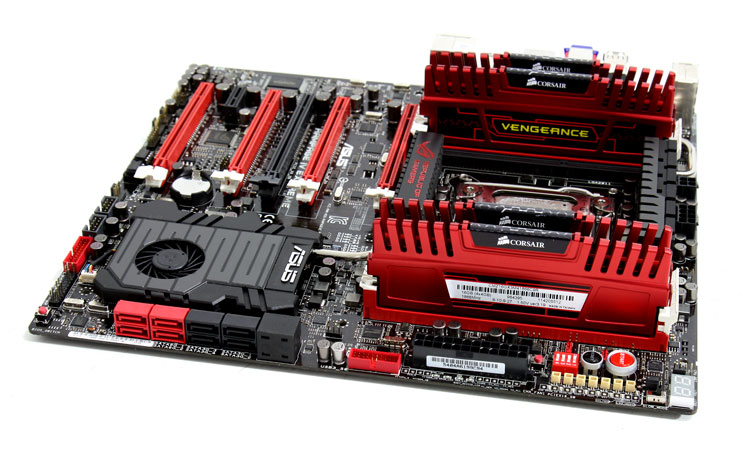Final words and conclusion
Final words and conclusion
When a product is so complicated and stuffed with features like the R4E it really is getting harder and harder to cover anything and everything in a review. We do hope you have gotten a good idea what the Rampage IV Extreme is all about. Its really shocking to see a motherboard holding so many features. The ROG Rampage IV Extreme as such really is a hardcore piece of machinery targeted at a very specific audience.
But let me get one thing out of the way first. Ya'll have probably noticed that the baseline performance of the processor is faster than reference. ASUS is being a little sneaky, and we have observed this before. Typically when you stress a Core i7 3960 on all cores the turbo mode will set two cores at 3700 MHz, two at 3800, two 3900 and once all cores stressed it will bin down all cores to 3600 MHz.
ASUS has changed the Turbo bin variable for you at default to 3900 MHz on all cores when the processors Turbo's kick in. So If all cores are in use they all run at 3900 MHz, hence the baseline performance offset.
If you have another brand of motherboard, look up in your BIOS, as in each and every motherboard BIOS you can select and configure the turbo multipliers manually with a K or X model processor. The difference with this board is that ASUS already applied that tweak by default for you. This by the way is also the reason why the overall TDP is slightly higher than the others when the processor is 100% stressed.
So in retrospect, the all new processor combined with this motherboard equals a truly hardcore PC that allows flexible overclocking and performance levels that are near silly when overclocked.
The overall design is quite nice to the eyes, the features nearly silly (only one Ethernet jack though!) but yeah .. it's hard to imagine anything better than this really.

We can't state this enough, where most others have failed ASUS has their uEFI BIOS tuned to near aptness. We've mentioned it a couple of times already, but it is by far the best implementation to work with. Fast, responsive, a well designed layout and simply easy to work in and with. Even a step further like flashing your BIOS in a uEFI GUI browsing say a flash-disk simply works brilliantly. There's nothing more to say about the uEFI implementation as it's simply downright good.
Features wise you'll be in a for the royal treatment as well, as it is just a very complete motherboard. I mean let me sum up some of the primary ones: up-to 4-way NVIDIA SLI and CrossFireX setups, eight SATA ports, four of which work at 6Gbps speeds, on-board Power, Reset and Clear CMOS buttons, a BIOS debug display, voltage measurement points and four DIP switches for disabling each of the four PCI-E x16 slots, eight USB 3.0 ports (four at the rear / four for frontpanel) and two eSATA ports and then the little extras like ASUS ROG Connect (overclock through another computer or laptop, dual-BIOS and so on. Oh and we even haven't mentioned all the pro-overclockers LN2 related features.
The ROG OC Key then, this is thinking out of the box, I like the feature as it works really well. It is just very handy to get a monitoring overlay on your screen from which you can tweak and overclock on the fly. The OC Key dongle itself is a little too long for my taste though, hopefully in future versions they can get the physical size down as that is not a pretty sight. But two thumbs up for the innovation as it is a very clever feature.
As stated in the reference Sandy bridge-E article, the Intel X79 chipset by all means is sufficient, but just that. We expected more SATA3 ports and native USB 3.0 amongst others. Manufacturers like ASUS adapt and react to that by adding ICs and compensate for the chipset, the more components are used driving prices upwards and is what is making X79 motherboards more expensive.
Being the top range flagship motherboard loaded with all the dreamy features does make this a very expensive motherboard. We have received the preliminary prices and you can expect a price tag of roughly 432 / 450 USD. 
With a motherboard that shows above default baseline performance and then all he features, functions and design .. yeah that's a win in my book. However 432 EUR + 900 EUR for just the motherboard and a processor, seems to be reaching into insane budgets needed for getting your overclocking freak on.
Regardless of the money you need to put down on the table, the Rampage IV Extreme is an absolute delight for the enthusiast end user and pro-overclocker, extreme is the keywords that defines this motherboard the best. Well worth a Top pick award, oh and ooh, we can't wait to see a Black edition to be released ;)
- Leave/read comments on this product
- Sign up to receive a notice when we publish a new article
- Or go back to Guru3D's front page
